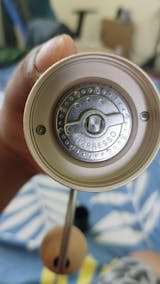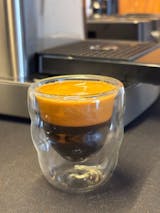We Started Using the 'Golden Ratio' to Brew Coffee. It Changed Everything

Share
Master the ideal coffee-to-water ratio to achieve consistently balanced flavour every single time.
Your morning coffee shouldn't be a gamble. If it's brilliant one day and undrinkable the next, you're not dealing with bad beans or a faulty machine—you're brewing without a proper method.
Professional baristas aren't keeping secrets, but they are following a proven standard: the Golden Ratio. It's the coffee industry's baseline for extracting the right amount of flavour from your grounds.
Master this ratio, and you'll finally stop wasting money on premium beans only to ruin them with brewing guesswork. You'll know exactly how much coffee and water you need, which means you can replicate that perfect cup on command—or adjust it deliberately when you want something stronger or lighter.
I started using the Golden Ratio, and my morning coffee has never been better.
What is the Golden Ratio?
The Golden Ratio refers to the ideal proportions of water and ground coffee at the beginning of the brewing process, resulting in a full-flavoured, balanced cup.
The Specialty Coffee Association, the international organization that sets coffee brewing standards, recommends a ratio between 15:1 to 18:1—that's 15 to 18 grams of water for every 1 gram of coffee.
The sweet spot? 16:1. That means for every gram of coffee, you use 16 grams (or millilitres) of water.
Practical Examples for Indian Coffee Drinkers
For a single cup (250ml): Use 15-16 grams of coffee grounds
For a large mug (350ml): Use 22 grams of coffee grounds
For a full pot (1 litre): Use 60-65 grams of coffee grounds
The goal of this precise ratio is flavour—the appropriate strength to taste the actual coffee without elevated acidity (which reveals under-extraction) or bitterness (which reveals over-extraction). This ratio works whether you take your coffee black or with milk and sugar.
The Golden Ratio is Based on Weight, Not Volume
Here's where most people go wrong: measuring coffee by volume instead of weight.
A tablespoon of fine filter coffee powder weighs differently than a tablespoon of coarse French press grounds. The density changes, which means your ratio becomes inconsistent.
For the Golden Ratio to work, you need to measure by weight using a kitchen scale. A quality coffee scale like the MHW-3BOMBER Cube Coffee Scale makes a massive difference in consistency and takes the guesswork out of brewing.
If you don't have a scale yet, a standard tablespoon holds approximately 5-7 grams of medium-ground coffee. So for 250ml of water, you'd use roughly 2-3 tablespoons—but this is an approximation, not precision.
Adjusting the Ratio to Your Taste
The 16:1 ratio is a starting point, not a rule carved in stone. Here's how to adjust:
For stronger coffee (like South Indian filter coffee): Try 14:1 or 15:1. This works well if you're adding milk.
For black coffee: Try 17:1 or 18:1 for a cleaner, lighter cup that highlights the coffee's natural flavours.
For cold brew: Use 8:1 or 10:1, as the cold extraction process is less efficient and requires more coffee.
The higher the number in the ratio (which represents water), the gentler or weaker the resulting brew. The lower the number, the stronger and more concentrated.
Other Factors That Influence Your Coffee
The ratio alone isn't enough to ensure an optimal cup. These elements also play a significant role:
Grind Size
The size of the grind determines how quickly water extracts flavour from your coffee.
Fine grind (like rava): For South Indian filter coffee and espresso
Medium grind (like table salt): For drip coffee makers and pour-over
Coarse grind (like sea salt): For French press
Using the wrong grind size will throw off your extraction, even if your ratio is perfect.
Water Temperature
Water should hit your coffee grounds at 90-96°C (195-205°F). Boiling water (100°C) is too hot and will make your coffee taste burnt and bitter.
If you're boiling water in a kettle, let it sit for 30-45 seconds after boiling before pouring. This brings it down to the ideal temperature range.
Water Quality
Coffee is 98% water, so the quality matters. If your tap water tastes of chlorine or has a strong mineral taste, it will affect your coffee.
Use filtered water if possible. In cities like Delhi, Mumbai, or Bangalore where water quality varies, this can make a noticeable difference.
Coffee Freshness
Fresh beans will always taste better. Look for coffee roasted within the last 2-4 weeks, and store it in an airtight container away from heat and light.
Once you grind coffee, it starts losing flavour within 15-20 minutes. If possible, grind your beans just before brewing.
Best Practices for Consistent Coffee
1. Invest in a Kitchen Scale
This is the single most important tool for consistent coffee. The MHW-3BOMBER Cube Coffee Scale is perfect for precise measurements and even includes a timer for pour-over brewing. Weigh both your coffee and your water for the best results.
2. Use Fresh, Quality Coffee
The Golden Ratio won't fix bad coffee. Invest in freshly roasted beans from local roasters. Look at tasting notes, try different origins (Ethiopian for fruity notes, Colombian for balanced sweetness, Indian Arabica for chocolatey flavours), and find what you enjoy.
3. Get a Burr Grinder
If you're serious about coffee, a burr grinder is the best investment you can make—even more important than an expensive coffee maker.
Burr grinders create uniform particle sizes, which means even extraction. Blade grinders create uneven grounds, leading to both over-extraction (bitterness) and under-extraction (sourness) in the same cup.
Check out our range of precision grinders:
- DF64 - 64mm Flat Burr Coffee Grinder for home use
- DF83V Gen 2 - 83mm Red Speed Flat Burr Coffee Grinder for serious enthusiasts
- 1Zpresso X-Ultra Manual Coffee Grinder for portability and precision
4. Be Consistent
Pick a method that works for your lifestyle. If weighing coffee every morning feels like too much effort, you'll stop doing it.
Find a routine you can maintain—whether that's pre-measuring coffee the night before, using the same mug every day, or setting up your brewing station for convenience.
Experiment until you find what you like, then stick with it.
The Bottom Line
Great coffee isn't complicated, but it does require attention to detail. The Golden Ratio gives you a reliable starting point that takes the guesswork out of brewing.
Start with 16 grams of coffee for every 250ml of water. Adjust from there based on your taste. Use a scale for consistency. Pay attention to grind size, water temperature, and coffee freshness.
Do this, and you'll finally get the most out of those premium beans you're buying. Your morning coffee will go from hit-or-miss to reliably excellent—every single day.







